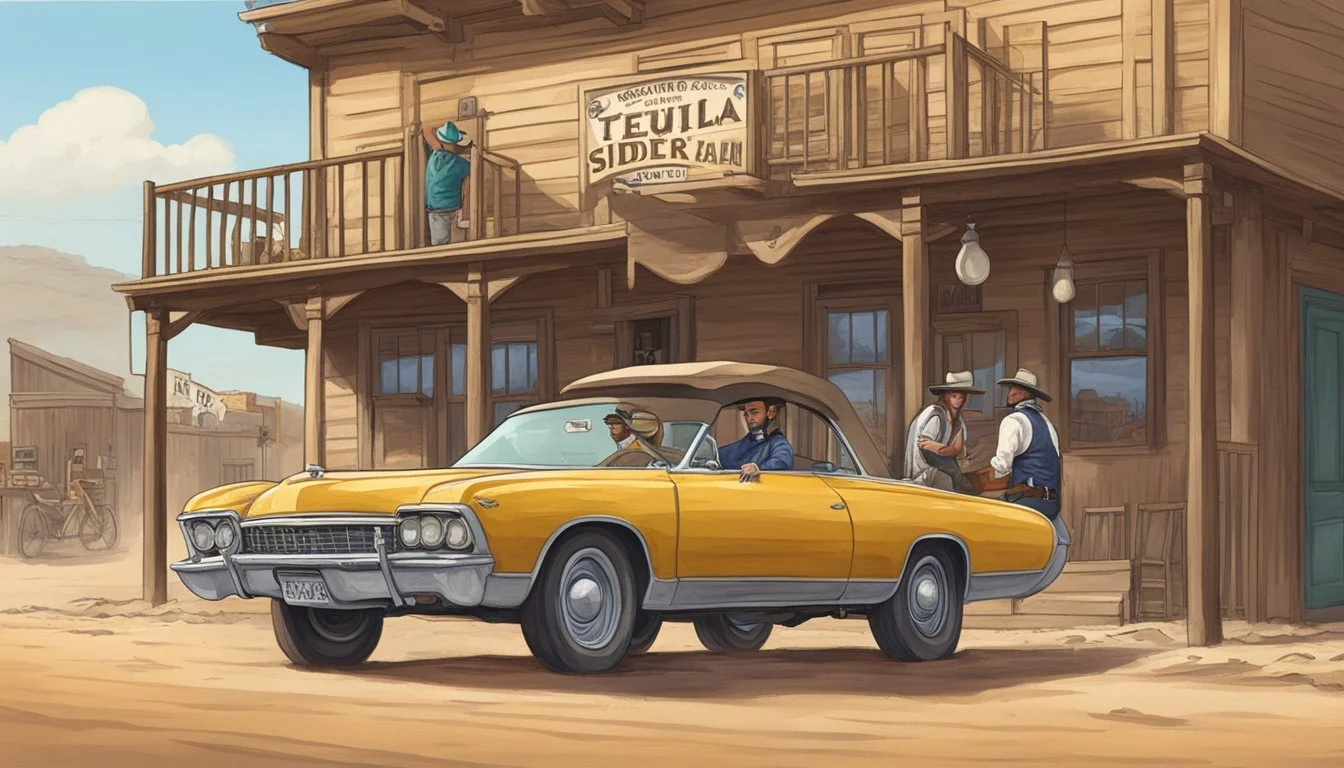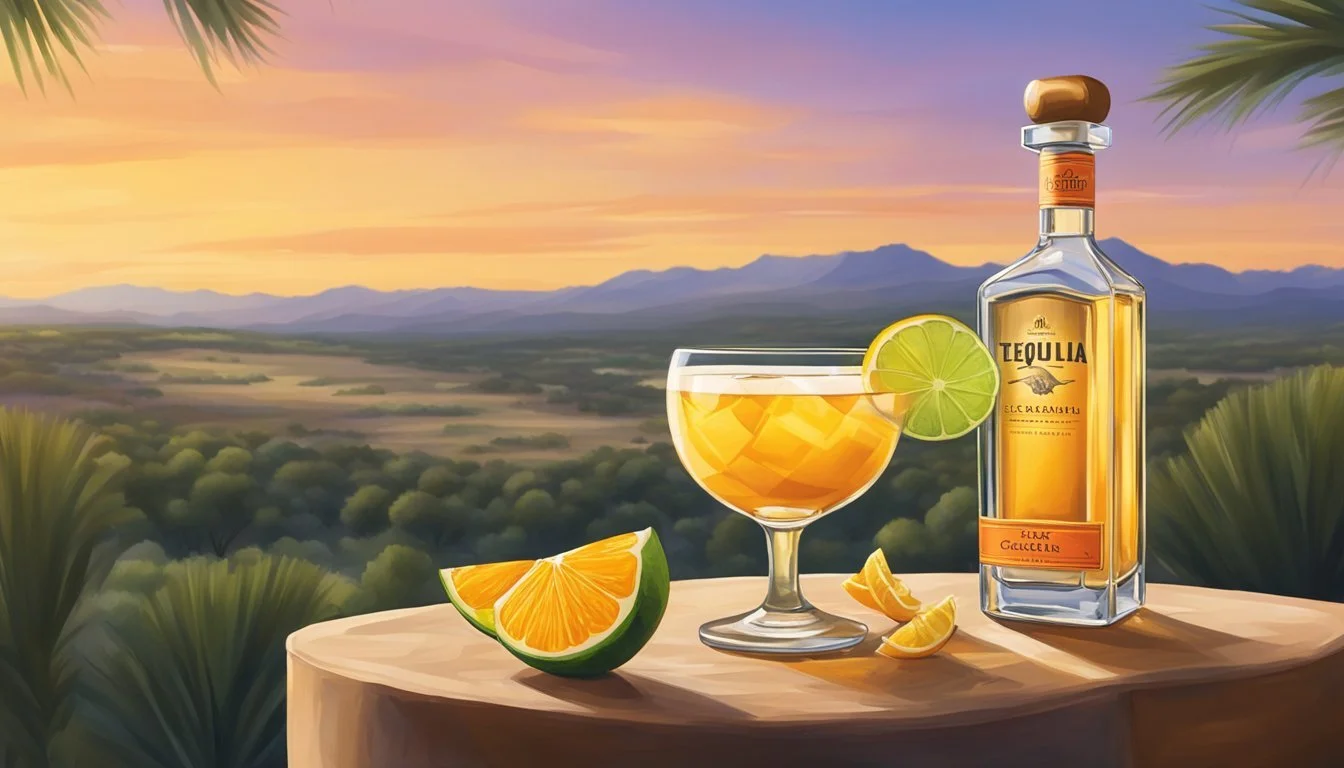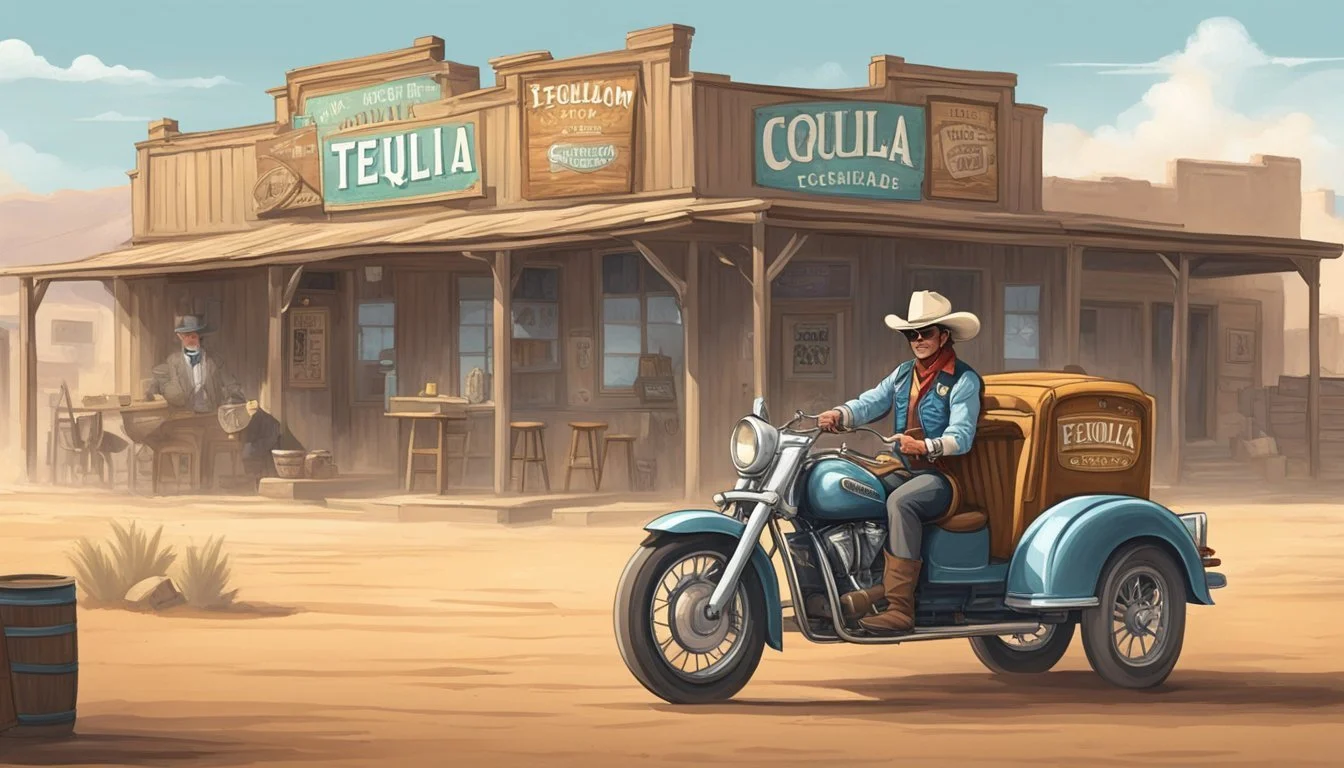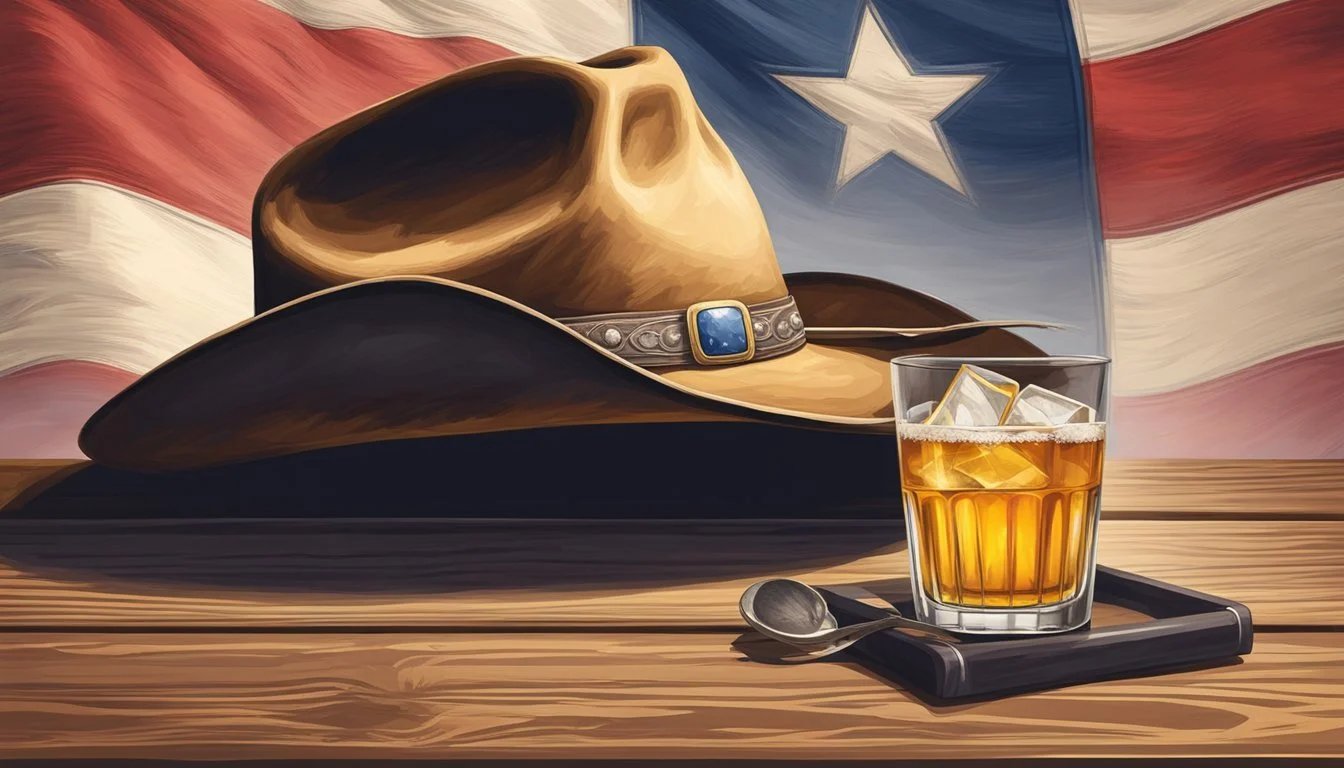The Tequila Sidecar
Elevating a French Classic with Bold Texas Flavors
The classic Sidecar cocktail, a storied drink hailing from France, traditionally features a melody of cognac, orange liqueur, and lemon juice. This concoction is revered for its elegant balance between sweet and sour notes, anchored by the rich warmth of brandy. As with many classic cocktails, the Sidecar has inspired a diverse range of variations, each offering a unique take on the original recipe that reflects different cultural and regional tastes.
In Texas, a reimagined version of this beverage has emerged, aptly named the Tequila Sidecar. This iteration pays homage to the classic by maintaining the essential structure of the drink but introduces a bold substitution: the use of tequila in place of cognac. The substitution is more than a simple swap of spirits; it's a transition that carries with it the heart of Texan cocktail culture, embracing the region's affinity for tequila and its storied connection to the local palate.
The Tequila Sidecar retains the original's charm while incorporating the distinctive characteristics of aged Añejo tequila. This variety of tequila, known for its time spent maturing in oak barrels, contributes a light smokiness and nuanced flavors of caramel that interplay with the bright citrus and sweet elements of the cocktail. The result is a drink that resonates with both the storied past of the French classic and the spirited influence of Texas, offering a refreshing and complex taste experience for enthusiasts and newcomers alike.
Historical Background
The Tequila Sidecar exemplifies the fusion of classic French cocktail artistry with the bold spirit of Texas. This synthesis brings forth a unique cocktail experience rooted in history and regional flair.
Origins of the Sidecar Cocktail
The Sidecar cocktail is believed to have emerged around the end of World War I, with its origins tied to Paris and London. The drink is often credited to an American army captain who was transported in a motorcycle sidecar during the war. The cocktail became a staple in the Parisian bar scene, with Harry MacElhone, owner of Harry's New York Bar in Paris, often associated with its creation or popularization.
A predecessor to the Sidecar is the Brandy Crusta, a venerable cocktail hailing from 1850s New Orleans. This archetypal drink set the stage for what would evolve into the Sidecar, as it was one of the first cocktails to include citrus—a defining feature of the Sidecar.
Notable Ingredients:
Cognac (traditionally Martell or Courvoisier)
Triple Sec
Evolution of the Classic in Texas
In Texas, the classic Sidecar was given a distinct twist by substituting the traditional cognac with tequila. The transformation inclusively embodied the Texan spirit—bold and unapologetic—while still respecting the cocktail's classical structure. This regional variation mirrors the global progression of cocktails, showcasing how the Sidecar has been adapted to local tastes without losing its core identity. The Texas rendition of the Sidecar also paved the way for other variations such as "Between the Sheets," demonstrating the versatility and enduring popularity of the original recipe during and beyond the Prohibition era.
The Anatomy of the Tequila Sidecar
The Tequila Sidecar elevates the traditional template with robust agave flavors, replacing cognac with tequila. This modification demands an understanding of its components to preserve the classic balance of sweet and sour.
Choosing the Right Tequila
The foundation of any Tequila Sidecar is, naturally, tequila. One should opt for an añejo tequila for its oak and vanilla notes, which come from a longer aging process. This maturity complements the cocktail's profile, offering a depth akin to the traditionally used cognac.
The Role of Citrus
Citrus provides the essential sour flavors to contrast with the sweetness. Lemon juice is most traditional, but lime juice is also common, especially in a Tequila Sidecar, supporting the agave notes with its tartness. Freshly squeezed juice ensures the bright, vibrant citrus kick required for this drink.
Adding Sweetness with Liqueurs
Sweetness in a Tequila Sidecar not only balances the citrus but also rounds out the tequila's sharpness. Orange liqueur is the standard, with options like Cointreau, Triple Sec, and Grand Marnier offering varying levels of sweetness and complexity. A dash of simple syrup may also be used to fine-tune the cocktail's sweetness.
The Importance of the Sugared Rim
A sugared rim adds textural contrast while providing intermittent bursts of sweetness that complement the drink's sweet and sour flavors. This garnish, involving a rim coated in sugar—preferably caster sugar for its fine texture—should be included meticulously, enhancing both aesthetics and taste.
Deconstructing the Recipe
The Tequila Sidecar transforms the well-known French classic by substituting tequila for cognac, while maintaining the balance and punch of the original cocktail. This section explores the precise ratios, techniques, and garnishing nuances that make this variation a standout.
Ingredient Ratios and Variations
The quintessential Tequila Sidecar consists of añejo tequila, orange liqueur, and lemon juice in a 2:1:1 ratio—two parts tequila to one part each of orange liqueur and lemon juice. Variations encompass the use of Stirrings Pomegranate Martini Mix or honey syrup to introduce different flavor profiles, and some recipes may prefer lime juice over lemon for a tart twist.
Tequila: 2 oz
Orange Liqueur/Cointreau: 1 oz
Lemon or Lime Juice: 1 oz
Pomegranate Mix/Honey Syrup (Optional): 1 oz
Mixing and Straining Techniques
To marry the ingredients perfectly, one should use a cocktail shaker filled with ice. A vigorous shake for about 10-15 seconds not only combines the ingredients but chills the mixture to the ideal temperature. The cocktail is then strained into a coupe or martini glass, ensuring a smooth, crisp drink without ice shards.
Garnishing for Aesthetics and Flavor
A garnish adds both visual appeal and a burst of aroma to the Tequila Sidecar. Commonly, a lemon twist is expressed over the drink to release citrus oils, then rimmed along the glass or dropped in for subtle flavor infusion. For a touch of elegance and extra taste, an orange peel wrapped around a cinnamon stick can be placed in the glass. If one desires a sugared rim, they can moisten the edge with a lemon wedge and dip it into sugar prior to adding the cocktail.
Cocktail Equipment Essentials
When crafting the Tequila Sidecar, one must consider the proper equipment essentials for both presentation and preparation. They are the foundation to delivering an authentic and enjoyable cocktail experience.
Selecting the Perfect Glassware
The allure of the Tequila Sidecar is greatly enhanced by its presentation. For this cocktail, glassware choice impacts both aesthetics and the tasting experience.
Cocktail Glass: A staple for many, but the Tequila Sidecar shines in specific glassware.
Coupe Glass: Historically, the coupe's broad bowl showcases the cocktail's color and allows for an aromatic experience with every sip.
Martini Glass: A viable alternative, offering a classic and elegant presentation.
Each type of glass is selected for its capacity to complement the cocktail's flavor profile and visual allure.
Shakers and Bar Tools
Accurate construction of the Tequila Sidecar requires quality shakers and tools.
Cocktail Shaker: Essential for chilling and integrating the Tequila Sidecar's ingredients. The cocktail shaker should seal tightly and be robust enough to withstand vigorous shaking.
Material Benefit
Stainless Steel Durable and excellent for temperature control
Glass Allows visibility of the cocktail's consistency while shaking
Bar Tools: Additional accessories that aid in the preparation include:
Measuring jiggers: For precise ingredient ratios
Bar spoon: For stirring, when shaking isn't appropriate
Hawthorne strainer: To strain out ice and pulp after shaking
Each tool is essential in the technique, ensuring that the drink is balanced, perfectly mixed, and free of unwanted ice or fruit remnants.
Beyond the Drink
When one considers the Tequila Sidecar, it transcends beyond mere refreshment. It becomes an experience enriched by proper food pairings and suitable occasions that accentuate its zesty and spicy character.
Food Pairings
Pairing food with a Tequila Sidecar shifts the focus from the drink to the gastronomic journey it can accompany. Bold flavors stand up well to the cocktail's vivacity. A sugar-rimmed glass beautifully contrasts and complements dishes with a hint of spice or warmth. Selections such as grilled shrimp with a lime glaze offer a refreshing counterpart, while a charcuterie (What wine goes well with charcuterie?) board bursting with rich, aged cheeses brings out the cocktail’s fruit notes.
Spicy Appetizers: They enhance the jalapeño or spice notes in the cocktail.
Citrus-infused Dishes: Reflects the zesty lime juice component.
Desserts: A sugar-rimmed glass aligns with sweet treats accenting the cocktail's sweetness.
Occasions for a Tequila Sidecar
The Tequila Sidecar lends itself to a spectrum of events, celebrating its versatility and appeal. Ideal for warm, sociable gatherings, where its spirited essence can shine, this cocktail is often the life of the party at events such as barbecues or cocktail hours. It exudes a sense of sophistication at dinner parties when served in a sugar-rimmed glass, making it a preferred choice for those who appreciate the finer aspects of mixology. Moreover, the Tequila Sidecar's bold yet balanced profile makes it an excellent choice for holiday festivities, where spice and warmth are in abundance.
Casual Get-togethers: Its refreshing nature makes it a hit.
Formal Affairs: The refined sugar rim adds an elegant touch.
Seasonal Celebrations: Adapts well to themes with its zesty twist.
Remixing the Classic
In the world of cocktails, reinvention is a tradition unto itself. Remixing the classic Sidecar introduces new flavors and cultural dimensions to this storied drink, originally a blend of brandy, lemon juice, and triple sec.
Experimental Ingredients
When bartenders take on the challenge of reimagining the Sidecar, they often experiment with the base spirits. The traditional brandy is sometimes swapped for tequila, lending the drink a Texan flair. This switch not only changes the character from smooth and rich to bright and robust but also encourages further innovation with other ingredients. For instance, an infusion of hibiscus can complement the agave tones of tequila, adding a floral complexity and a vibrant hue.
The sour component of the Sidecar, typically lemon juice, also sees variation. Adventurous mixologists might opt for other citrus like lime, or even incorporate sour mixtures that play with taste and texture. To sweeten the cocktail, while traditional recipes call for triple sec or Cointreau, bartenders might introduce alternatives such as agave syrup or local honey to harmonize with the tequila base.
Cultural Twists on the Traditional Recipe
The infusion of local culture into the Sidecar's recipe transforms it in ways that honor both the drink's heritage and the region's tastes. A Margarita is essentially a tequila-based Sidecar with a salted rim, highlighting the cultural exchange between French and Mexican cocktail traditions. Meanwhile, other classic cocktails can inspire the Sidecar’s remixing process. For instance, the Between the Sheets cocktail, a cousin of the Sidecar, introduces rum into the mix for a slightly sweeter and more potent drink.
In Texas, the Tequila Sidecar might be garnished with a twist of grapefruit instead of the traditional lemon, to give a nod to the state's citrus heritage. In the same vein, the inclusion of local spirits such as Texan-made gins can replace brandy, offering a lighter, more botanical profile, touching on the flavors found in a Gin Sour.
On occasion, bartenders may draw inspiration from such iconic cocktails as the Old Fashioned or the Manhattan, employing techniques like muddling or the use of bitters to introduce depth and a touch of bitterness, creating a complex and balanced twist on the classic French Sidecar.
Cultural Impact and Legacy
The Tequila Sidecar has left a distinct imprint on cultural avenues such as literature, film, and the histories of iconic bars. Embracing the spirit of the classic Sidecar, this Texas variation has expanded upon the legacy of the drink's association with sophistication and adventure.
The Sidecar in Literature and Film
The classic Sidecar cocktail—typically comprising brandy, Cointreau, and lemon juice—has been a symbol of class and taste in both literature and film. In cinematic experiences, its appearance often signifies a character's refined palate, while literary references to the Sidecar paint it as a drink of the worldly and well-traveled. This cocktail’s cultural impact is heightened by its connection to the roaring twenties, further romanticizing it through Martell's and other Brandy label's endorsements.
One cannot mention the Sidecar without conjuring images of its namesake, the motorcycle sidecar—a vehicle synonymous with early 20th-century adventure and daring. Such adventurous connotations have woven the drink into historical narratives that project the freedom of the open road paralleled with suave sophistication.
Iconic Bars and the Sidecar's Place in History
Many bars boast of a signature Sidecar on their menu, often using classic recipes as a foundation before adding their own regional or innovative spins. The Sidecar has a storied relationship with illustrious establishments where bartenders have honed the art of balancing its flavors.
Classic Recipe: Brandy, Cointreau, Lemon Juice
Bourbon Sidecar: Replacement of Brandy with Bourbon
White Lady: Gin-based version
Brandy Crusta: Precursor to the Sidecar
Bars in Texas have embraced the Tequila Sidecar, infusing it with añejo tequila and local ingredients like pomegranate, reflecting Texas's rich cultural tapestry. This practice not only roots the drink in local heritage but also underscores the continuing evolution and relevance of the Sidecar in cocktails history. The Sidecar has journeyed from the Brandy Crusta to a beloved classic whose variations, like the Tequila Sidecar, keep the tradition both alive and geographically diverse.
Nutrition and Selection
When crafting a Tequila Sidecar, nutrition and the choice of tequila are crucial factors to consider for cocktail enthusiasts who are conscious about their calorie intake and flavor profiles. The appropriate selection of tequila can alter not only the taste but also the caloric content of the drink.
Counting the Calories
A Tequila Sidecar generally consists of añejo tequila, orange liqueur, and citrus juice. The calorie count can vary depending on the specific ingredients and their quantities. On average, a cocktail serving typically has between 200 to 300 calories. These are primarily from the alcohol and the sweet components of the liqueur. It's important to note that additional garnishes or sweeteners can increase the calorie count.
Choosing an Añejo over VSOP
Añejo tequila is aged longer than other tequilas, usually for one to three years in oak barrels, imbuing the spirit with a complexity that can enrich a Sidecar significantly. While the traditional Sidecar often features VSOP (Very Superior Old Pale) Cognac, which is aged at least four years, using an añejo tequila instead injects a bold, nuanced flavor typical of fine aged spirits. An aficionado selecting añejo tequila should expect a fuller body and smoother finish, with caloric content comparable to that of a VSOP.
The Modern Sidecar and Social Media
The Tequila Sidecar has evolved from a classic cocktail into a vibrant social media sensation. Today, this cocktail not only tantalizes the palate with its subtle sweetness and citrusy zing, but also captivates the eye on platforms such as Instagram.
Cocktails in the Age of Instagram
The picturesque nature of the Tequila Sidecar makes it a favorite subject for Instagram users. Key ingredients like orange bitters or Angostura bitters and the bright hues of the drink itself create an aesthetic appeal that encourages sharing. For many at-home bartenders and professional mixologists, Instagram has become a showcase for their cocktail crafting skills, and the Tequila Sidecar, with its visual allure and taste profile, takes center stage.
Key Instagram Trends:
Vivid cocktails
Interactive stories showcasing preparation
Hashtags like #TequilaSidecar and #CocktailArt
How to Present Your Tequila Sidecar
When presenting a Tequila Sidecar on Instagram, attention to detail is paramount. Glassware choice enhances the visual appeal, and garnishing with an orange twist not only complements the subtle sweetness of the cocktail but also adds to its photogenic qualities.
Glassware: A chilled coupe glass is traditional and photogenic.
Garnish: An orange twist expresses essential oils and provides a pop of color.
Backdrop: A simple, elegant backdrop ensures the cocktail remains the focal point.
Lighting: Natural lighting can highlight the drink's clarity and color gradients.
Hashtags and a brief story concerning the drink's inspiration or creation process can engage followers further and encourage interaction. This is how the Tequila Sidecar continues to garner admiration and attention in the digital era.







